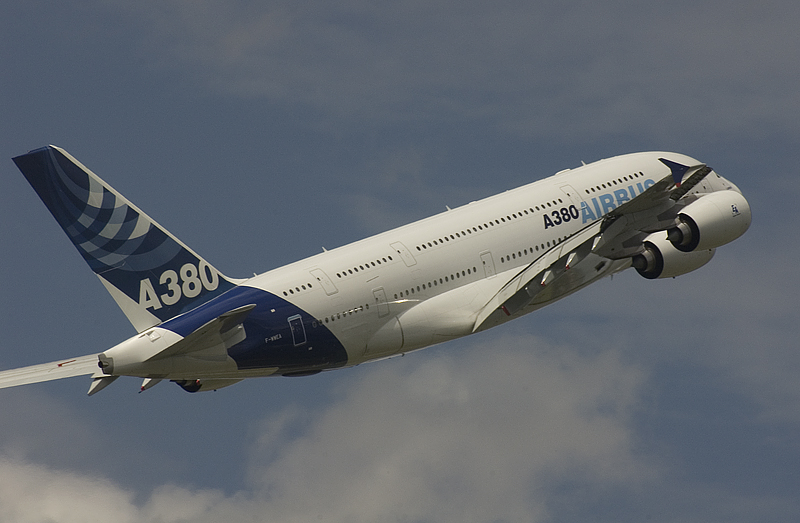
First flight:The first flying aircraft MSN01 F-WWOW will remain the property of Airbus. At the first flight on April 27, 2005 the A380 took off at a weight of 421.000 kg, the highest ever of any civil airliner to date. During the flight, which took the aircraft around South West France, the six crew members explored the aircrafts flight envelope as expected. They tested the A380s handling using both direct and normal flight control laws with the landing gear up and down, and with all flaps and slats settings during the part of the flight at cruise altitude. They made an initial evaluation of the comfort levels in both the main and upper decks, confirming that the cabin was very quiet and the ride smooth.
This maiden voyage, during which all primary flight test objectives were met, marks the beginning of a rigorous test flight campaign involving five A380s, including one for the certification of the Engine Alliance GP7200 engine on the A380, and some 2.500 flight hours. It will culminate in the aircrafts certification followed by its entry into airline service in the second half of 2006 with first operator Singapore Airlines. The scope and rigour of the A380 ground and flight test program should also prepare for a smooth entry into service, planned for 2006
Future models will include the shortened, 480 seat A380-700, and the stretched, 656 seat, A380-900. (The -700, -800, and -900 designations were chosen to reflect that the A380 will enter service as a “fully developed aircraft” and that the basic models will not be soon replaced by more improved variants).
The A380 assembly building (Toulouse) is one of the largest in the world, measuring 500 m by 250 m, with a height of 46 m. It is the largest of several buildings on the site which, together, incorporate more than 32.000 tons of steel the equivalent of four Eiffel towers or the Millau viaduct – plus 250.000 cubic meters of concrete.
Fuselage:
The A380 has a twin deck configuration with new lighter and even more resistant material is also being used for the first time on a civil airliner after intensive trials. The upper fuselage shell of the A380 is fashioned from GLARE, a laminate alternating layers of aluminum and glass-fiber reinforced adhesive. In addition to being some ten per cent less dense than aluminum – for a weight-saving of around 800 kg – GLARE has proven superior in terms of fatigue as well as fire and damage resistance.
Engines:
The Rolls-Royce Trent 900 is being certificated at 80,000lb thrust, a rating considerably higher than the requirement at entry into service, allowing substantial margin for potential growth. Last year the engine achieved 88,000lb thrust in the early stages of testing.
The Trent 900 will enter service in Spring 2006 with Singapore Airlines and has also been selected by Qantas, Virgin Atlantic and Lufthansa, giving it a 48 per cent share of firm and option orders.
Developed under the Engine Alliance joint venture of Pratt & Whitney and General Electric, the GP7200 benefits from technology mastered by America?s two largest jet powerplant manufacturers. Pratt & Whitney is responsible for the GP7200s low-pressure system, including its large main fan with highly swept titanium blades a key element in the engine?s low noise output. General Electric developed the core section for the GP7200, which incorporates the companys experience in lowering jet engine emissions and boosting operational efficiency. Airbus customers selecting the GP2700 for their A380s are Air France, Emirates, FedEx and International Lease Finance Corporation.
As the choice of launch customer Singapore Airlines (SIA), the Trent 900 is the leading engine for the A380 development program.
| Developing Nation: | Europe. |
| Manufacturer/Designer: | EADS / Airbus Industries. |
| First Flight: |
April 27, 2005 F-WWOW. |
| First passengers flight: | September 4, 2006 (500 passengers) |
| First Delivery: | October 15th 2007 (Singapore Airlines). |
| First Operational: | October 25th 2007 (Singapore-Sidney). |
| A380-800 passengers aircraft | |
| Crew: | 2. |
| Passengers: | 555 in three-class. |
| Cabin Length: | 50,68 m. |
| Fuselage Diameter: | 7,14 m. |
| Max. Cabin Width Main Deck: | 6,58 m. |
| Max. Cabin Width Upper Deck: | 5,92 m. |
| Cargo volume: | 171 m³, (38 LD3 containers) |
| Wing Span: | 79,8 m. |
| Wing Area: | 845 m. |
| Wing sweep: | 33.5 degrees. |
| Length: | 73 m. |
| Height: | 24,1 m. |
| Wheel base: | 30,4 m. |
| Wheel track: | 14,3 m. |
| Engine (s): |
4 Rolls-Royce Trent 900 or 4 GP 7200 Turbofans with 311kN trust. |
| Weight: |
– Empty: 276.800 Kg. – Zero fuel weight: 361.000 Kg. – Internal fuel: 310.000 liters. – Max. payload: 66.400 Kg. |
| Max. Take off weight: | 560.000 Kg. |
| Max. Landing weight: | 386.000 Kg. |
| Cruise Speed: | 902 km/h. |
| Max. Speed: | 945 km/h. |
| Service ceiling: | 13.106 m. |
| Max. Range: | 15.000 km. |
Freighter:
The A380 Freighter has three decks of standard containers, accessible simultaneously through five doors, and offers more payload and more range capability than current freighters.
| A380-800F Freighter | |
| First Delivery: | 2008. |
| Crew: | 2. |
| Total cargo volume: | 4.04 m³. |
| Containers upper-deck: | 17 – 25. |
| Containers main-deck: | 29 – 33 |
| Containers lower-deck: | 13 |
| Wing Span: | 79,8 m. |
| Wing Area: | 845 m². |
| Length: | 73 m. |
| Height: | 24,1 m. |
| Engine (s): |
4 Rolls-Royce Trent 900 or 4 GP 7200 Turbofans with 340 kN trust. |
| Weight: |
– Empty: 252.200 Kg. – Zero fuel weight: 402.000 Kg. – Internal fuel: 310.000 liters. – Max. payload: 152.400 Kg. |
| Max. Take off weight: | 590.000 Kg. |
| Max. Landing weight: | 427.000 Kg. |
| Cruise Speed: | 910 km/h. |
| Max. Speed: | 0,89 mach. |
| Service ceiling: | 13.106 m. |
| Max. Range: | 10.400 km. |
All pictures courtesy of Zijde Aviation Photo and Publishing, Rob Vogelaar / Marcel van Leeuwen
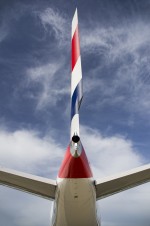























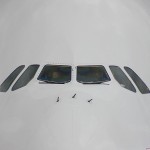
























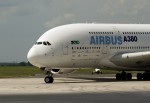









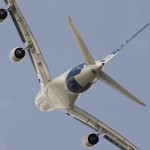






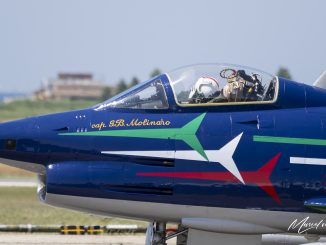
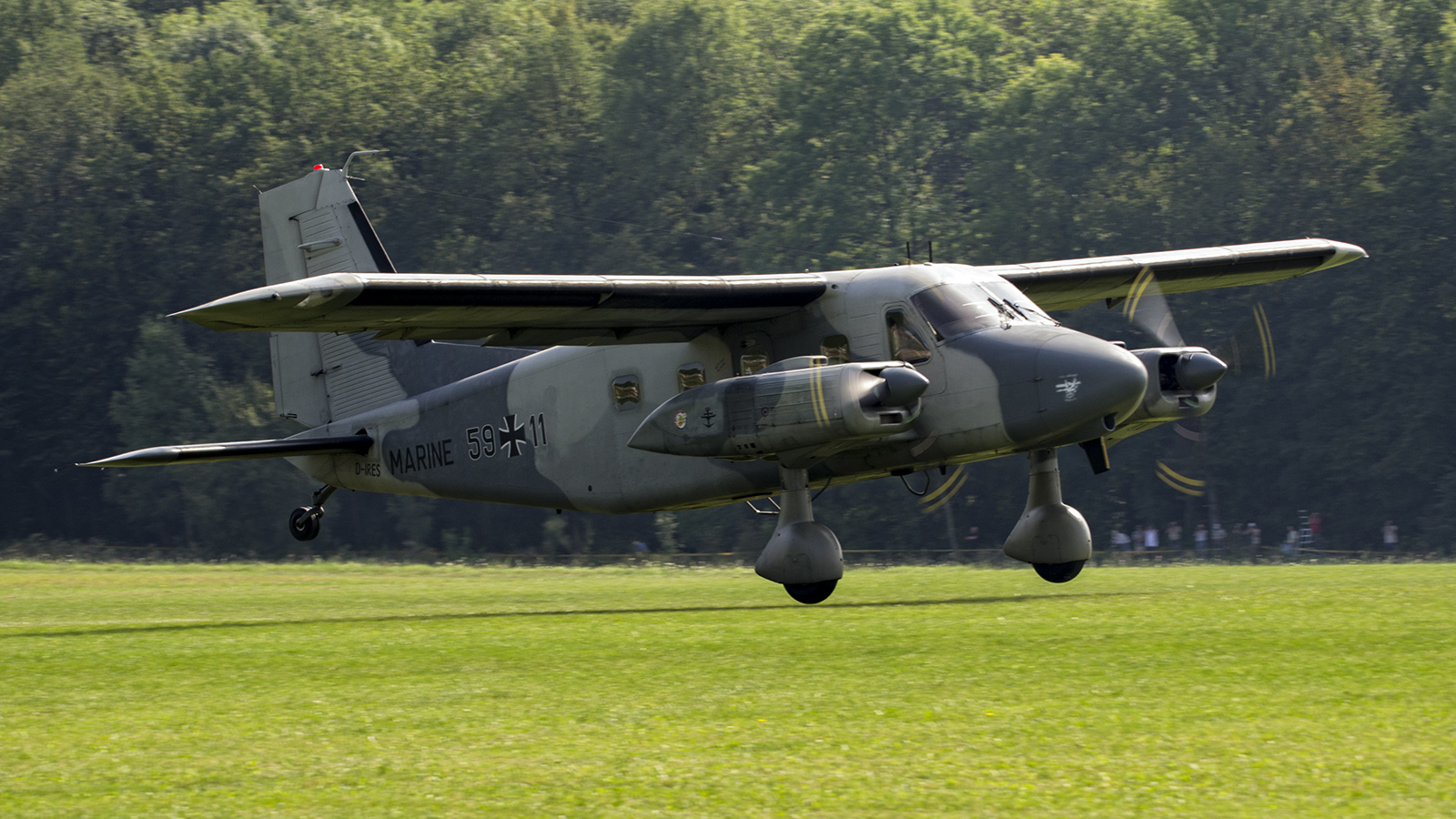
Be the first to comment